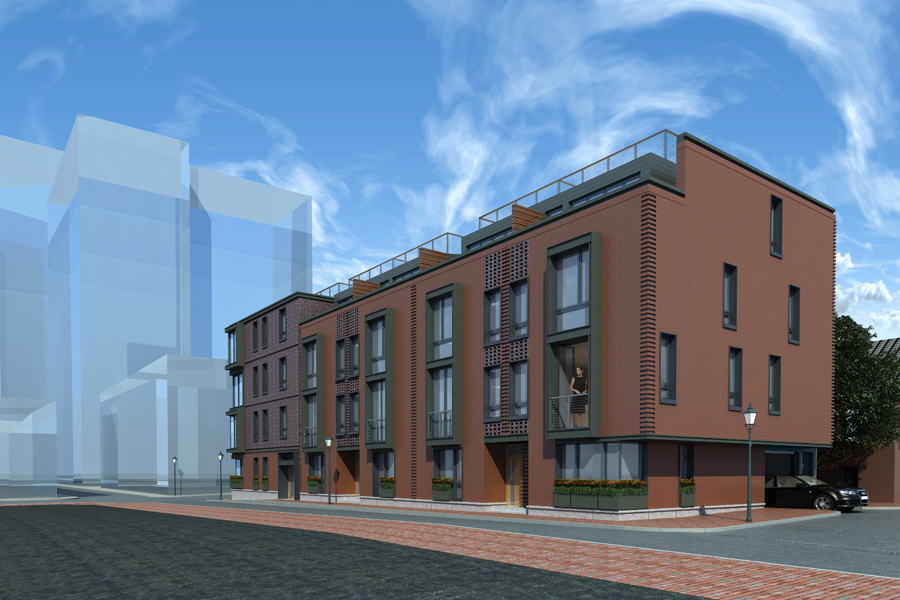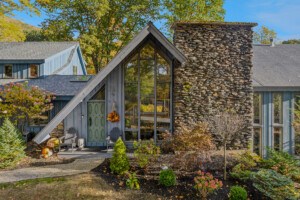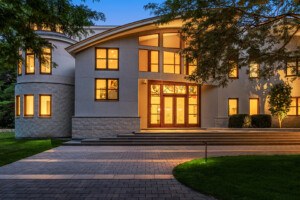Condominiums to Rise on Site of Cocoanut Grove Fire

Rendering provided
On November 28, 1942, a fire broke out at the Cocoanut Grove restaurant/supperclub on Piedmont Street in Bay Village, killing 492 patrons. Now, 72 years later, a new eight-unit condominium project is under construction on the site.
On Monday, Danielle Bing and Serafin Sanchez, of Gibson Sotheby’s International Realty, began marketing the Piedmont Park Square condominiums. The new project will include four two-bedroom, floor-through units with 1,100-1,600 square feet priced from $1.2 million, as well as four single-unit rowhouses with 3-4 bedrooms and 2,600-3,000 square feet priced from $2,792,000, according to their website.
The Cocoanut Grove fire holds a significant place in city and national history. In its heyday, the club had more than 10,000-square feet of space, including three bars and lounges, as well as room for dining and dancing below a stage where the house band performed. It spread between three buildings a city-block wide, nestled among Broadway, Shawmut, and Piedmont Streets. Today, the roads have been reconfigured, and the Revere Hotel actually occupies much of the physical space where the club was located. These eight new homes will rise on the remaining land, which for much of the past 70 years has been a surface parking lot on Piedmont Street:

The night of the fire, Cocoanut Grove was filled to twice its capacity when the flames broke out, and hundreds of people became trapped inside due to unmarked exists, doors that opened inward instead of outward, and a club owner who wouldn’t let people leave without paying (and who was later charged and sent to jail). Within minutes, the Boston Fire Department had the fire under control, but it was too late. The death toll was first estimated at 260 victims but eventually reached 490 dead with another 166 injured. (The Boston Public Library’s Flickr feed includes over 100 photos of the fire and its aftermath.)
The fire stunned the city’s residents and shocked the rest of the nation, even as Americans were dealing with the deaths and injuries of Americans off fighting World War II. Few disasters of this magnitude had occurred before. Even today, it’s considered the fifth worst loss of life in U.S. history after September 11, Pearl Harbor, the Titanic, and the 1903 Iroquois Theatre fire in Chicago. Across the country, the tragedy led to changes in fire codes in cities involving lighting, exits, stairways, and signage. Methods used by doctors at MGH to treat burns and smoke inhalation became standard across the country.
These days, a simple plaque along the sidewalk honors those who died and were injured in the fire:
“Erected by Bay Village Neighborhood Association, 1993. In memory of the more than 490 people who died as a result of the Cocoanut Grove fire on November 28 1942. As a result of this terrible tragedy major changes were made in the fire codes and improvements in the treatment of burn victims, not only in Boston but across the nation. “Phoenix out of the Ashes”.
A smaller inscription in the lower left corner reads, “This plaque crafted by Anthony P. Marra, youngest survivor of the Cocoanut Grove fire.” The plaque has been removed while the construction continues.
Whether home buyers in the new Piedmont Park Square project will feel peace while living on the site of the fire is the question. Should nothing ever be built? The Cocoanut Grove disaster was three-quarters of a century ago; is it realistic to expect the site to remain empty forever? It’s certainly not unprecedented for land to be re-used in the city of Boston, or after other disasters claim lives. In Boston, the Hotel Vendome fire claimed the lives of nine firefighters in 1972; million-dollar condominiums are now on that site. In Chicago, the Iroquois Theatre eventually reopened. You decide:


